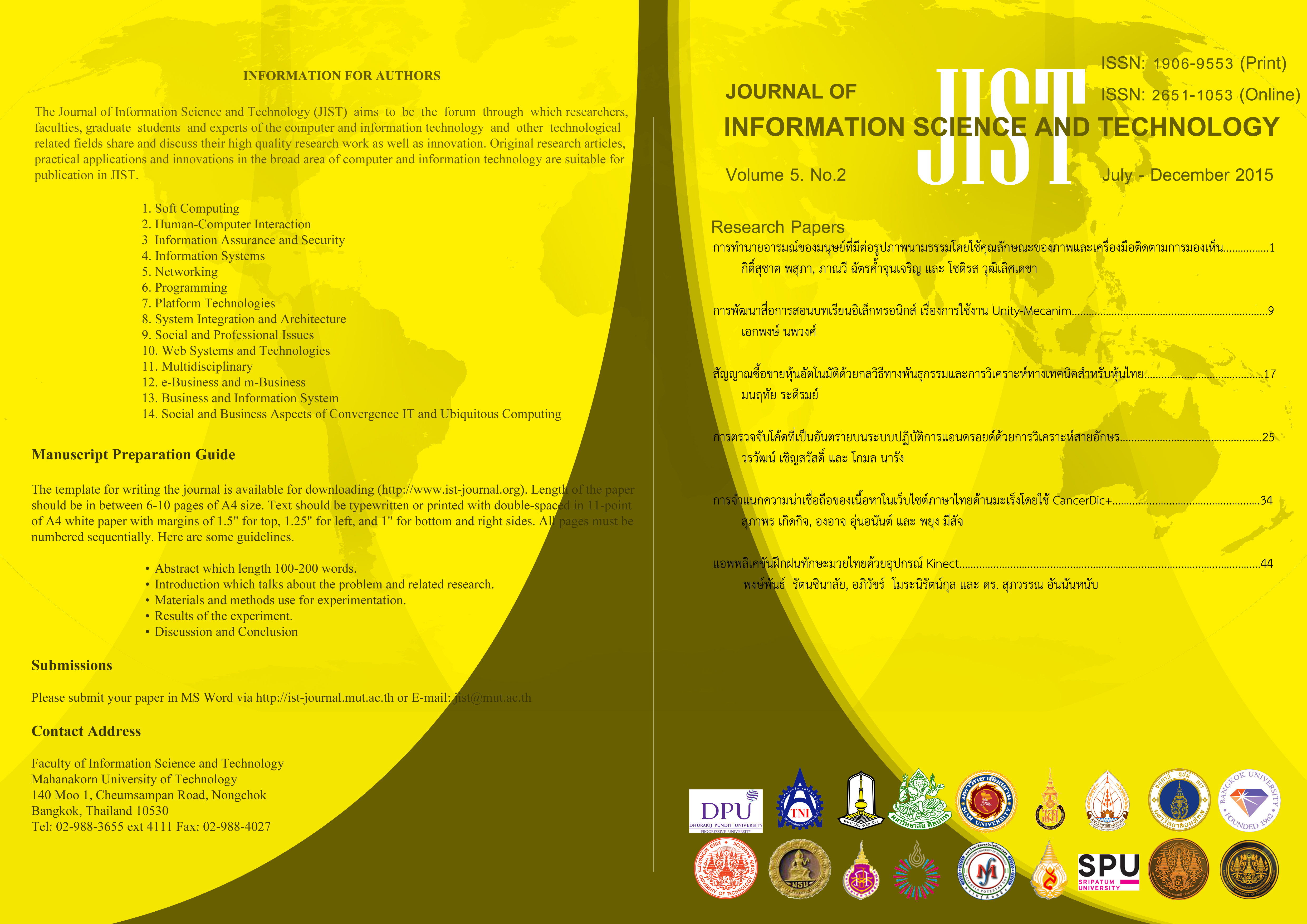Automated Trading Signals based on Genetic Algorithm and Technical Analysis for Thai Index
Main Article Content
Abstract
- The proposed system in this research can decide a trading strategy for each day and produce a high profit for each stock. Decision trading support model is used to capture the knowledge in technical indicators for making decisions such as buy, hold and sell. The system consists of two stages: elimination of unacceptable stocks and stock trading construction. On the first stage, the proposed approach selected 15 stocks that publicly traded in the Thai Stock Exchange 100 Index (SET 100) from the year 2014 through 2015. On second stage, the experimental results have shown Annual Sharpe Ratio and Return Profits higher than “Buy & Hold” models for each stock index, and the models that used a Genetic Algorithm to optimizing a trading signal has profit better than another models. Especially TS17 as GA model, Annual Sharpe Ratio of Training set was 0.54, and Return Profit for 422 trading day was 23.2%. In Testing set, Annual Sharpe Ratio of Training set was 1.54, and Return Profit for 66 trading day was 9.52%. The results are very encouraging and can be implemented to increase the efficiency of a Decision-Trading System during the trading day.
Article Details
This work is licensed under a Creative Commons Attribution-NonCommercial-NoDerivatives 4.0 International License.
I/we certify that I/we have participated sufficiently in the intellectual content, conception and design of this work or the analysis and interpretation of the data (when applicable), as well as the writing of the manuscript, to take public responsibility for it and have agreed to have my/our name listed as a contributor. I/we believe the manuscript represents valid work. Neither this manuscript nor one with substantially similar content under my/our authorship has been published or is being considered for publication elsewhere, except as described in the covering letter. I/we certify that all the data collected during the study is presented in this manuscript and no data from the study has been or will be published separately. I/we attest that, if requested by the editors, I/we will provide the data/information or will cooperate fully in obtaining and providing the data/information on which the manuscript is based, for examination by the editors or their assignees. Financial interests, direct or indirect, that exist or may be perceived to exist for individual contributors in connection with the content of this paper have been disclosed in the cover letter. Sources of outside support of the project are named in the cover letter.
I/We hereby transfer(s), assign(s), or otherwise convey(s) all copyright ownership, including any and all rights incidental thereto, exclusively to the Journal, in the event that such work is published by the Journal. The Journal shall own the work, including 1) copyright; 2) the right to grant permission to republish the article in whole or in part, with or without fee; 3) the right to produce preprints or reprints and translate into languages other than English for sale or free distribution; and 4) the right to republish the work in a collection of articles in any other mechanical or electronic format.
We give the rights to the corresponding author to make necessary changes as per the request of the journal, do the rest of the correspondence on our behalf and he/she will act as the guarantor for the manuscript on our behalf.
All persons who have made substantial contributions to the work reported in the manuscript, but who are not contributors, are named in the Acknowledgment and have given me/us their written permission to be named. If I/we do not include an Acknowledgment that means I/we have not received substantial contributions from non-contributors and no contributor has been omitted.
References
2. D. E. Goldberg, Genetic Algorithms in Search, Optimization and Machine Learning, Addison-Wesley, 1989.
3. D. de la fuente, A. Garrido, J. Laviada and A. Gomez, “Genetic algorithms to optimise the time to make stock market investment,” In Proc. of Genetic and Evolutionary Computation Conference, 2006, pp. 1857-1858.
4. A. Hirabayashi, C. Aranha and H. Iba, “Optimization of the trading rule in foreign exchange using genetic algorithms,” In Proc. 2009 IASTED International Conference on Advances in Computer Science and Engineering, 2009.
5. M. A. H. Dempster and C. M. Jones, “A real-time adaptive trading system using genetic programming,” Quantitative Finance, vol. 1, pp. 397-413, 2001.
6. Matsui and H. Sato, “A comparison of genotype representations to acquire stock trading strategy using genetic algorithms,” In Proc. Adaptive and Intelligent Systems, pp.129-134, 2009.
7. F. Allen, R. Karjalainen, “Using genetic algorithms to find technical trading rules,” Journal of Financial Economic, Vol.51, pp. 245-271, 1999.
8. F. Fern´ andez-Rodr´ ıguez, C. Gonz´ alez-Martel, S. Sosvilla-Rivero. (2001) Optimisation of Technical Rules by Genetic Algorithms: Evidence from the Madrid Stock Market, Working Papers 2001-14, FEDEA, [Online]. Available: ftp://ftp.fedea.es/pub/Papers/2001/dt2001-14.pdf
9. S. Mahfoud, G. Mani, “Financial forecasting using genetic algorithms,” Journal of Applied Artificial Intelligence, vol. 10, pp. 573-565, 1996.
10. (2012) MATLAB Global Optimization Toolbox [Online]. Available: http//www.mathworks.com/products/globaloptimization/
11. (2012) MATLAB Mixed Integer Optimization Problems, [Online]. Available:https://www.mathworks.com/help/toolbox/gads/bs1cibj.html#bs1cihn.
12. สุรชัย ไชยรังสินันท์, “การวิเคราะห์ทางเทคนิค (Technical Analysis),” [อ อ น ไ ล น์] https://soft2.me/e-book-technicalanalysis. pdf, 2552.
13. C. Neely, P. Weller, R. Ditmar, “Is technical analysis in the foreign exchange market profitable? A genetic programming approach,” In Proc. Forecasting Financial Markets: Advances for Exchange Rates, Interest Rates and Asset Management, London, 1997.



